Product List
Plastic Vacuum Forming
Description
Plastic vacuum forming is a process that involves heating a plastic sheet until soft and then draping it over a mould. A vacuum is applied sucking the sheet into the mould. The sheet is then ejected from the mould. In its advanced form, the vacuum forming process utilizes sophisticated pneumatic, hydraulic and heat controls, enabling higher production speeds and more detailed vacuum formed applications.
Application
Vacuum molding is used for Baths & Shower Trays, Yoghurt Pots, Ski-Boxes, Boat Hulls, Machinery Guards, Vehicle Door Liners, Refrigerator Liners, Sandwich Boxes, Parts of vehicle cabs, Exterior Shop Sign.
Advantages of Plastic Vacuum Forming
1. Since the process uses low pressures, the moulds can be made of inexpensive materials and mould fabrication time can be reasonably short.
2. Prototype, low quantity requirements of large parts and medium size runs lead to economical.
3. More sophisticated machines and moulds are used for continuous automated production of high volume items like yoghurt pots, disposable cups and sandwich packs.
4. Unlike other thermoplastic forming processes, where powder or resin are the starting point, vacuum forming uses extruded plastic sheet.
5. With vacuum forming a secondary process may be required to trim the formed sheet to arrive at the finished part. The trimmed waste can be recycled.
Vacuum Molding
Plastic Vacuum Forming Process
1. Clamping: The clamp frame needs to be sufficiently powerful enough to ensure the plastic sheet is firmly held during the forming process.
2. Heating: By close control of areas of heat intensity, heat losses around the edges caused by convection air currents and absorption from clamp areas can be fully compensated for and consistent results achieved on a continuous basis.
3. Plug assist: Once the plastic has reached its forming temperature or "plastic” state it can be pre-stretched to ensure even wall thickness when the vacuum is applied. The method of controlling the bubble height should be that consistent results are obtainable.
4. Vacuum: Once the material is suitably pre-stretched a vacuum can be applied to assist in forming the sheet. A dry vane vacuum pump is used to draw the air trapped between the sheet and the mould. With larger machines a vacuum reservoir is used in conjunction with a high volume capacity vacuum pump. This enables a two stages vacuum to be applied ensuring rapid moulding of the heated sheet (before the sheet temperature drops below its ideal forming temperature).
5. Cooling and release: Once formed, the plastic must be allowed to cool before being released.
6. Trimming and finishing: Once the formed part has cooled and been removed from the machine the excess material is removed. Holes, slots and cut-outs are then drilled into the part. Other post-forming processes include decoration, printing, strengthening, reinforcing and assembly.
Common Materials for Plastic Vacuum Forming
Virtually all thermoplastics can be supplied as sheet and vacuum formed.
Commitment
1. We provides a high quality affordable plastic vacuum forming, plastic vacuum molding solution according to customer requirements.
2. We will ensure the following services: suitable materials, affordable cost, reliable quality, test report and stable delivery.
3. We are able to utilize our low cost structures in China, and provide a low cost and reliable final plastic vacuum forming products, lower than almost any other countries plastic vacuum molding service supplier.
Plastic vacuum forming is a process that involves heating a plastic sheet until soft and then draping it over a mould. A vacuum is applied sucking the sheet into the mould. The sheet is then ejected from the mould. In its advanced form, the vacuum forming process utilizes sophisticated pneumatic, hydraulic and heat controls, enabling higher production speeds and more detailed vacuum formed applications.
Application
Vacuum molding is used for Baths & Shower Trays, Yoghurt Pots, Ski-Boxes, Boat Hulls, Machinery Guards, Vehicle Door Liners, Refrigerator Liners, Sandwich Boxes, Parts of vehicle cabs, Exterior Shop Sign.
Advantages of Plastic Vacuum Forming
1. Since the process uses low pressures, the moulds can be made of inexpensive materials and mould fabrication time can be reasonably short.
2. Prototype, low quantity requirements of large parts and medium size runs lead to economical.
3. More sophisticated machines and moulds are used for continuous automated production of high volume items like yoghurt pots, disposable cups and sandwich packs.
4. Unlike other thermoplastic forming processes, where powder or resin are the starting point, vacuum forming uses extruded plastic sheet.
5. With vacuum forming a secondary process may be required to trim the formed sheet to arrive at the finished part. The trimmed waste can be recycled.
Vacuum Molding
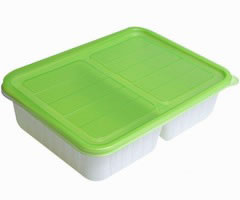
|
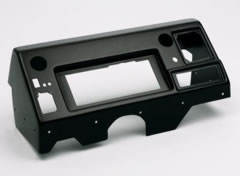
|
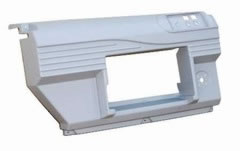
|
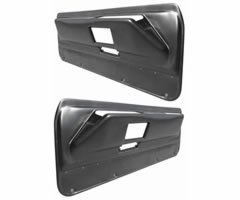
|
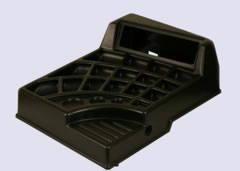
|
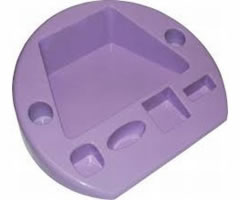
|
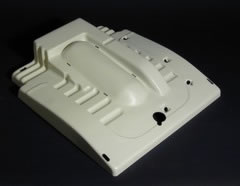
|
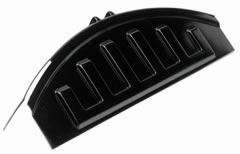
|
Plastic Vacuum Forming Process
1. Clamping: The clamp frame needs to be sufficiently powerful enough to ensure the plastic sheet is firmly held during the forming process.
2. Heating: By close control of areas of heat intensity, heat losses around the edges caused by convection air currents and absorption from clamp areas can be fully compensated for and consistent results achieved on a continuous basis.
3. Plug assist: Once the plastic has reached its forming temperature or "plastic” state it can be pre-stretched to ensure even wall thickness when the vacuum is applied. The method of controlling the bubble height should be that consistent results are obtainable.
4. Vacuum: Once the material is suitably pre-stretched a vacuum can be applied to assist in forming the sheet. A dry vane vacuum pump is used to draw the air trapped between the sheet and the mould. With larger machines a vacuum reservoir is used in conjunction with a high volume capacity vacuum pump. This enables a two stages vacuum to be applied ensuring rapid moulding of the heated sheet (before the sheet temperature drops below its ideal forming temperature).
5. Cooling and release: Once formed, the plastic must be allowed to cool before being released.
6. Trimming and finishing: Once the formed part has cooled and been removed from the machine the excess material is removed. Holes, slots and cut-outs are then drilled into the part. Other post-forming processes include decoration, printing, strengthening, reinforcing and assembly.
Common Materials for Plastic Vacuum Forming
Virtually all thermoplastics can be supplied as sheet and vacuum formed.
| Material name | Abbreviation | Description | Applications |
| Acrylic | PMMA | Rigid, brittle, scratch resistant, transparent, optical clarity, low/medium cost | Display stands, knobs, lenses, light housings, panels, reflectors, signs, shelves, trays |
| Acrylonitrile Butadiene Styrene | ABS | Strong, flexible, low mold shrinkage (tight tolerances), chemical resistance, electroplating capability, naturally opaque, low/medium cost | Automotive (consoles, panels, trim, vents), boxes, gauges, housings, inhalors, toys |
| Polycarbonate | PC | Very tough, temperature resistance, dimensional stability, transparent, high cost | Automotive (panels, lenses, consoles), bottles, containers, housings, light covers, reflectors, safety helmets and shields |
| Polyester - Thermoplastic | PBT, PET | Rigid, heat resistance, chemical resistance, medium/high cost | Automotive (filters, handles, pumps), bearings, cams, electrical components (connectors, sensors), gears, housings, rollers, switches, valves |
| Polypropylene | PP | Lightweight, heat resistance, high chemical resistance, scratch resistance, natural waxy appearance, tough and stiff, low cost. | Automotive (bumpers, covers, trim), bottles, caps, crates, handles, housings |
| Polyvinyl Chloride - Plasticised | PVC | Tough, flexible, flame resistance, transparent or opaque, low cost | Electrical insulation, housewares, medical tubing, shoe soles, toys |
Commitment
1. We provides a high quality affordable plastic vacuum forming, plastic vacuum molding solution according to customer requirements.
2. We will ensure the following services: suitable materials, affordable cost, reliable quality, test report and stable delivery.
3. We are able to utilize our low cost structures in China, and provide a low cost and reliable final plastic vacuum forming products, lower than almost any other countries plastic vacuum molding service supplier.
Inquire Now!
 English
English




